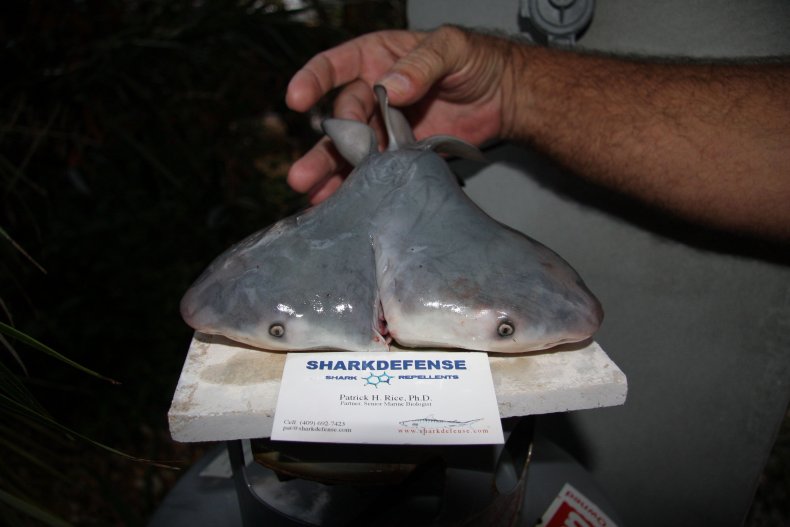We Might Be Driving a Rise in Two-Headed Sharks
The last two decades have seen an increase in reports of a sea creature so terrifying that it has earned its own low-budget film franchise: the two-headed shark. Every few years, these menacing mutants pop up into the public consciousness.
“The occurrence of a two-headed shark is rare,” Patrick Rice told Newsweek. He is chief science and research officer and principal investigator for marine research at the College of Florida Keys.
“As with any physiological abnormality, survival in the wild may be more difficult depending on the abnormality. This is the process of natural selection,” Rice added. “If the abnormality is advantageous to the organism, then the trait may be passed on to the next generation. But, usually, an abnormality of this magnitude results in death shortly after the shark is born.”

Patrick Rice/College of Florida Keys
The most recent report was in 2020, when a fisherman outside of the Indian town of Palghar found a baby shark with two heads in his bycatch.
In 2013, a two-headed bull shark was reeled in by a fisherman in the Gulf of Mexico near Florida, which was later studied by Rice and his colleagues. In 2008, another fisherman discovered a two-headed blue shark embryo in the Indian Ocean, off the coast of Australia.
Using an external examination, radiography and an MRI, Rice and his team were able to determine that the shark was a conjoined twin, where its skeleton and internal organs had divided into parallel systems halfway up its body, resulting in two well-developed heads. “The phenomenon occurs as a result of the incomplete division of a single fertilized egg, exactly like conjoined humans,” Rice said.

Patrick Rice/College of Florida Keys
All of the specimens reported so far have been fetuses—there have been no reports of fully grown adult sharks with this extra appendage. Whether this would even be possible is still unclear.
“There is not enough evidence to support that this abnormality allows them to survive for a long time as free-living animals,” Nicolás Ehemann told Newsweek. He is a researcher, associated with the Ichthyological Collection of the Interdisciplinary Center for Marine Sciences (IPN CICIM-PR) in Mexico, and he has studied these two-headed specimens.
Sharks can be found in all of our planet’s oceans, so these two-headed fetuses have been found all over the world. “Biologically, these two-headed shark cases have been documented most frequently in blue sharks,” Ehemann said. “This shark is a species with a circumglobal distribution that may travel considerable distances. [It is also] viviparous, producing up to 80 young per litter.”
Viviparous sharks are those that give birth to live young that have developed inside the body of their mother. It is thought that around 70 percent of the 500 shark species on the planet give birth to live young in this way. The other 30 percent are oviparous, meaning that they lay eggs.
Most of the two-headed shark specimens found so far have been viviparous. But, in 2016, the two-headed embryo of an oviparous species was found by researchers at the University of Malaga in Spain, while raising a clutch of catfish shark eggs in the lab. Conditions had been carefully controlled, so in this case, the abnormal specimen was most likely the result of a random genetic mutation. However, in nature, there may be other factors at play.
“The constant increase in fishing efforts on sharks from the 1980s to the present has undoubtedly depleted the populations of different species,” Ehemann said. “This has had repercussions, among other things, on the genetic diversity of the species, smaller sizes at maturity, and sexual reproduction that can affect the quality of the development of the embryos.”

Matrix Reloaded/Getty
Human activities have altered water quality in coastal areas, which may also contribute to the frequency of these mutants. “I believe that overfishing and pollution, among other issues, contribute to the phenomenon of abnormal sharks, including two-headed specimens,” Ehemann said.
“All these external stressors may enhance DNA mutation and incomplete splitting of the axis during embryonic development, resulting in abnormal individuals.”
However, both Ehemann and Rice think that there could be an alternative explanation. “Even if there are more reports, that could be a result of more people with smartphones, social media etc.,” Rice said.
Ehemann agreed. He said that the increase in reports might simply be a result of more-accessible recording technology. “I believe that the constant increase in human resources training, coupled with access to technology, is a factor that may seem to be an increasing—compared to the last century—prevalence of abnormalities, including two-headed sharks.
“Despite the information and reports of two-headed sharks generated annually, assuming a considerable or significant increase in the prevalence of this condition should be approached from an integrative perspective, considering the availability of research and technology [now compared to] former times.”
Do you have an animal or nature story to share with Newsweek? Do you have a question about sharks? Let us know via nature@newsweek.com.

Comments are closed.